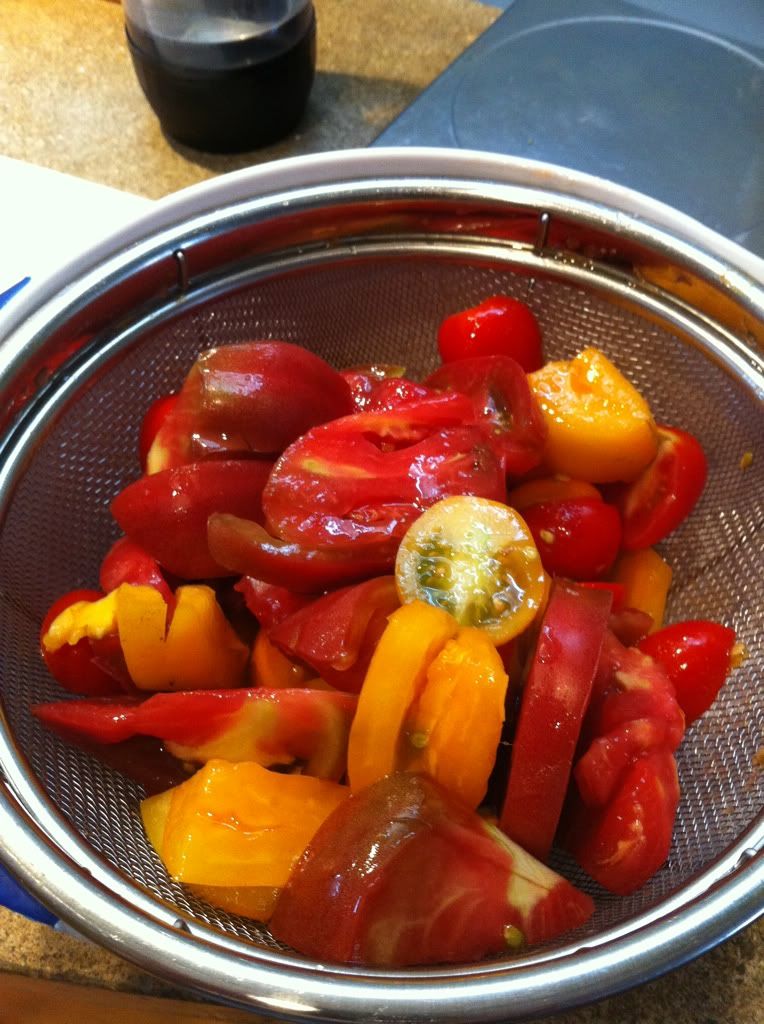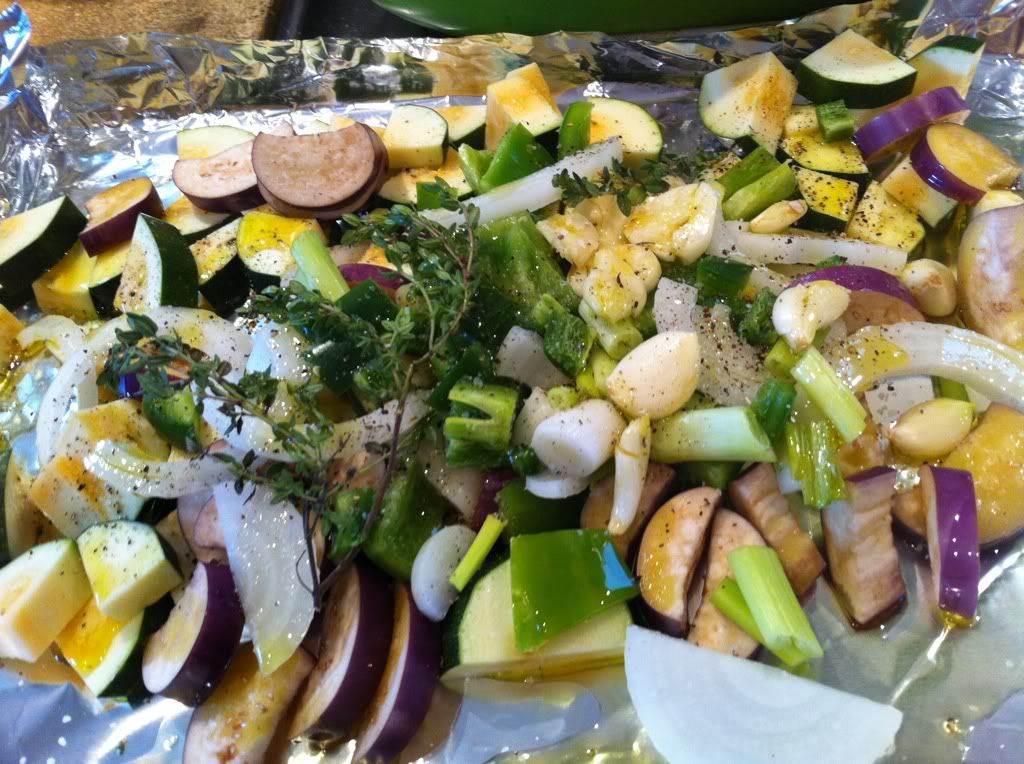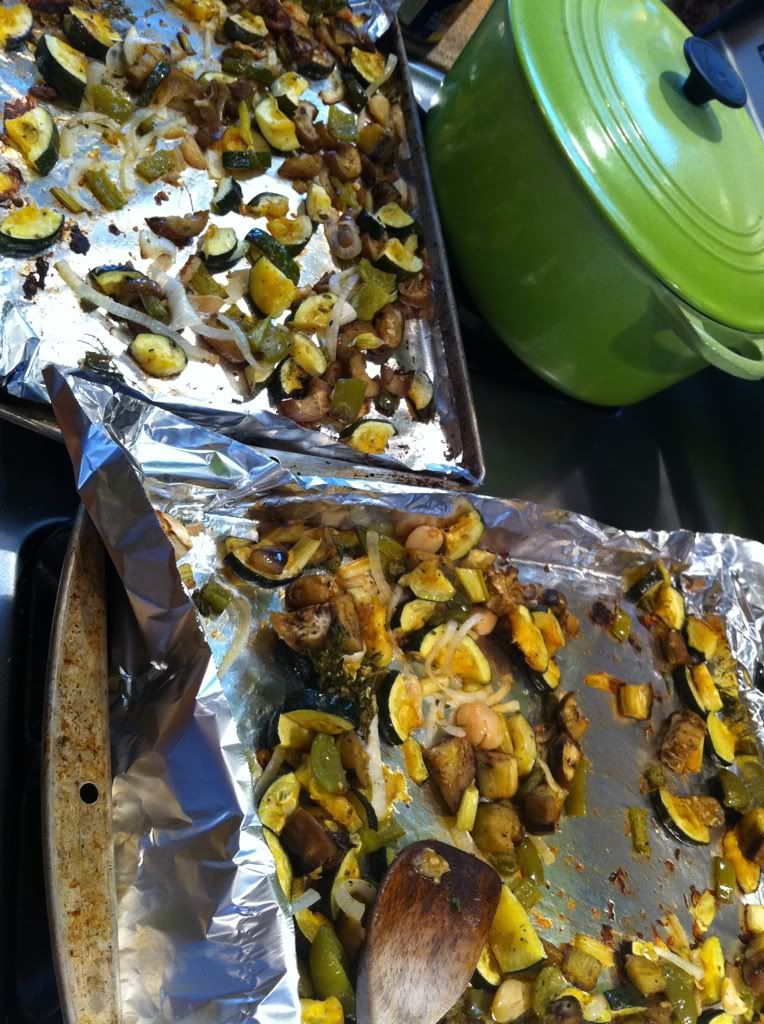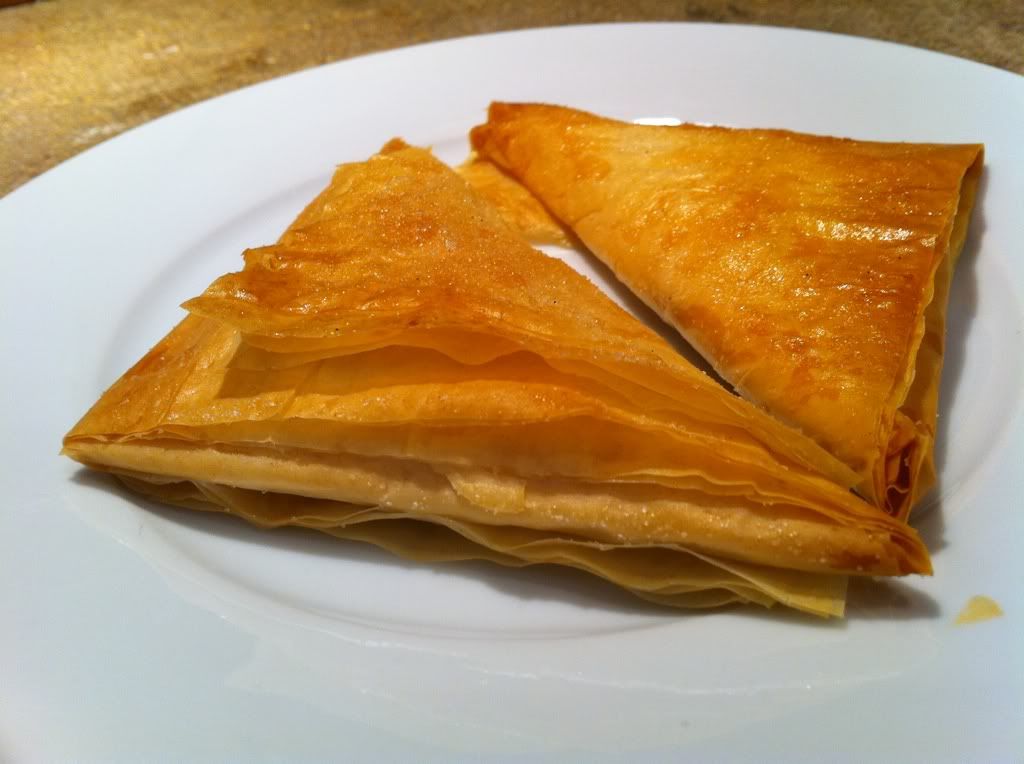by Xani
The other day I embraced an empty house, some free time, and an abundance of summer produce. I cooked, cooked, and cooked some more, and loved every minute of it. Later, while reflecting on all I made that day, I realized that all my creations were essentially building blocks, which could be combined with each other and other staples to create hundreds, maybe thousands of dishes. For me, this was something of a revelation, and I'm not sure why I didn't think of it before. When you prepare one ingredient or element for a particular recipe, be it a sauce, filling, cooked starch, whatever, there is no rule that says that all of that element must be used for just that recipe! Why not make double the "element" and use the rest for some entirely different preparation? Makes a lot of sense, doesn't it? Wait, maybe it doesn't. Let me show by example:
Breakfast:
On this particular day, I had eggs for breakfast. Eggs might be the most perfect "master recipe" in themselves because they can be prepared in innumerable ways, and combined with so many different ingredients. Normally, I'm an omelet or scramble kind of girl. Maybe you'll find me eating one fried, or even poached, if I'm feeling fancy. On this day, I rooted through the fridge and found some sun-dried tomatoes, soft goat cheese, and fresh basil from the farmers market (sadly our basil, along with all the other herbs in the garden, gave up and died somewhere around the second or third 100+ degree day here in Baltimore. RIP). I started out intending to make an omelet, but ended up with a scramble because I don't have a proper omelet pan (hint, hint... I want this one if someone else is buying!), and I was using a crepe pan and lets face it, a messed-up omelet tastes just as good if you call it a scramble.
Anyway, my point is that an omelet/scramble is an ideal master recipe because you can put almost anything in there. Leftovers, or extra of whatever "element" you prepared for some other dish, make great fillings- bits of meat, vegetables, even leftover rice or pasta will be great in there (Dave once made me an omelet filled with leftover mac and cheese that was a triumph!). You can do a Mexican-inspired one (beans, cheese, salsa), French (caramelized onions and Gruyere), Indian (have we ever blogged about BCD Dad's amazing curried vegetable omelet filling? It is to die for!), etc, etc. And if you eat eggs almost every day, you begin to realize how comforting it is to have a recipe/technique that 1) is quick and very easy, 2) can be varied in infinite ways, so you never get bored, and 3) can easily utilize leftovers or anything else that happens to be in your fridge. It's a tiny miracle!
Lunch:
Around lunchtime I started throwing together two other Master recipes. One, if I'm using its proper name, is a "Mothership" recipe. Jamie Oliver's tomato salad is basic, but that's the point. You take perfectly ripe, preferably heirloom, tomatoes of all shapes and sizes, cut them up, salt and drain them, and combine with a little olive oil, vinegar, garlic, herbs and chili. And then what? WHATEVER YOU WANT. There is seriously so much you can do with this. On his "Tomato" episode of Jamie at Home, he uses it several ways: as is, with huge hunk of fresh mozzarella on the side, for an amazing summer salad; chopped up with additional herbs for a salsa to serve on chicken or fish; and tossed with just-cooked pasta for a super-quick meal. But, there's even more you could do with this basic recipe: put it on toasted, thick bread slices as bruschetta, or puree it all up for a cold tomato soup, and then maybe strain it for more of a tomato consomme (he also prepares something like this in the Tomatoes episode). Top a pizza or flatbread. Maybe slow-roast the tomatoes and see what becomes of them? I guess the trick of using a master recipe is being willing to get experimental and see what happens. There's no rules! And that can be scary...
For my next Master recipe, I tackled roasted vegetables. Now, this is not brain surgery. It's the height of summer so I used zucchini, eggplant, peppers (green, red, jalapeno-- basically everything I had in the fridge), scallions, onions, and garlic. Cut up everything into about the same size pieces, maybe a square inch or so, but you certainly don't have to measure. Let's call it "bite-sized." Toss everything with a good dose of olive oil, lots of salt and pepper, and throw on whatever herbs and spices suit your fancy-- here I used thyme. Now spread onto a big sheet tray-- make sure you only have a single layer of vegetables, use two trays if you have to-- and put everything in a pre-heated 425 degree oven. Roast, stirring occasionally, until everything is soft, and there are brown caramelized bits on some of your vegetables (it will probably take less than an hour, depending on what veggies you are using and how much). And that's it! Your roasted veggie Master recipe is complete. So now what?
For starters, you can eat it plain, warm, room temperature or cold, as a super-easy lunch or side dish to a protein (steak? grilled fish? sure!). Maybe jazz it up with some feta cheese or a poached egg. Or, put it in an omelet! Puree it with broth to make a soup (hot or cold). Stir it into risotto. Use it as a filling for quiche, a pizza topping, or panini filling. Mix it with a little ricotta and use it as a filling for calzone or in lasagna. Mix it with cheddar and fry it up in a quesadilla. Or mix with cooked and cooled quinoa, bulgur, brown rice, or your favorite grain, add a little vinaigrette, and eat as a salad. That's about a dozen options right there and I just made those up right now! Think of all the other ideas I could come up with if I didn't have a job!
Another note on the roasted veg master recipe-- this is not limited to summer veggies. Oh no. This would be equally as good, and have just as many applications, if you made it with fall/winter veg: butternut squash, carrots, turnips, rutabaga, sweet potatoes, regular potatoes, etc. If you are wondering whether a vegetable can be roasted, just Google "roasted ______." Chances are someone else has already tried to roast it, and you can learn from their success or failure. The only "rules" for this dish are: keep pieces about the same size, so they will cook evenly, use a hot oven, use olive oil and season well with salt and pepper. I would also highly recommend using onion and/or garlic (because I love these things more than I can say) and herbs (because, why not? You can always use that dried crap that's taking up room in your cabinet. It won't be as good as using fresh, but it won't hurt).
So what did I ACTUALLY do with these recipes? For starters, I made pasta sauce for dinner using both the tomatoes and the veggies. I mushed up (that's a technical term) a cup or two of the tomato salad with my hands to make sure all the pieces were a manageable size, then added that mush to some onions I was gently sauteing in olive oil. Then I added more garlic, a pinch more oregano, some red pepper flakes. Cooked that for a while until some of the excess liquid had evaporated. Then, I added a cup or so of the roasted veggies. Stirred everything together, let it "marry" in the pot for about 10 minutes while the pasta cooked, then added the drained pasta to the sauce. Topped with some shaved Parmesan and chopped fresh basil, I'd call that a helluva dinner!
Later in the week I used some of the tomato salad to make one of my rapidly-becoming-famous "quinoa confetti salads," and ate the roasted veggies in, yes, a scramble, with feta.
But the day wasn't done and I wanted a sweet treat. The next master recipe is more like a master ingredient: phyllo dough. I cannot express how ridiculously versatile this is. You can buy it at any grocery store, keep it in the freezer for eternity, and defrost it in your fridge and keep it there for a couple weeks in a totally-ready-to-use state. I think people are afraid of phyllo because its translucent and fragile, and TV cooks always walk about "working quickly" and "covering with a damp towel to prevent drying out." Really, it's not that temperamental, and can be very forgiving, as I will discuss. The basic master recipe here is phyllo triangles or turnovers. I'm going to discuss sweet applications, but you can and should also fill them with any type of savory filling (including the roasted veg above, maybe mixed with a little ricotta or mascarpone?? See, I just made that up!).
The real trick to phyllo is the layering. You need about 4 layers to create these turnovers. Between each layer you need a thin coating of fat. For a sweet preparation, you are probably going to want to use butter, although I bet coconut oil would also work. Either way you want to have your fat melted and have a brush to apply it (that said, in savory preparations, I sometimes use olive oil. I have this gadget which allows you to coat the layers lightly and evenly).
So, you break out your phyllo, and start layering. Lay one sheet down on your work surface. Brush this layer with the fat. Lay another sheet down directly on top of the first. Brush with fat. Repeat. Don't worry if you have tears or holes in a sheet-- just make sure your NEXT layer covers them up. After 4 or 5 layers, you should have a good, solid sheet going. Cut the sheet longways so you have two long strips. Now, put about a half tablespoon of filling on one of the short ends of the dough. What filling you ask? Well, this is a MASTER recipe, so use what you've got! Personally, I used Nutella, which was awesome. You could also use jam or fruit butter, fruit curd, peanut or other nut butters, bits of fresh or dried fruit, or nuts, mixed with jam or mascarpone... let your imagination run wild! Yes, there is a chance that your filling could turn out too wet, and leak all over the place, which would kindof suck. But, you clean up, and move on, and next time, you try something else. Kindof like LIFE.
Ahem, anyhow, back to the recipe. Starting at the filling-topped end, begin folding each dough strip, corner to corner, like you were folding a flag. If you want, you can continue brushing melted butter (or whatever) on each layer of the fold. When you get to the end, fold under any excess dough and you should be left with a neat triangle. Brush the top with butter and sprinkle with a bit of sugar. Place on a tray, into a pre-heated 400 degree oven (or, if you are me, the toaster oven) and bake for about 15 mins until the dough is a nice golden brown. By then, your filling should be warm (and gooey, if you are using Nutella). Eat immediately, and celebrate your creativity-- you have embraced the Master Recipe!
Lately I've been trying to rely more on my cooking instincts instead of following recipes, and I think that's why the Master recipe idea is so compelling. You make one good thing, and you can turn it into dozens of other good things. It's so freeing to be able to trust your instincts and realize you don't have to keep running back to that cookbook or the computer screen to check whether it was a teaspoon or a teaspoon and a HALF of whatever-- just trust your instincts, be zen, and let it happen. (NOTE: Does not apply to baking!)
So what about you, do you have a Master Recipe you like to make? What do you do with it? Please share in the comments!
X
Subscribe to:
Post Comments (Atom)
Blog Archive
-
►
14
(5)
- ► 10/12 - 10/19 (1)
- ► 09/28 - 10/05 (1)
- ► 02/02 - 02/09 (1)
- ► 01/19 - 01/26 (2)
-
►
13
(13)
- ► 12/29 - 01/05 (2)
- ► 12/01 - 12/08 (1)
- ► 11/03 - 11/10 (1)
- ► 10/06 - 10/13 (1)
- ► 06/16 - 06/23 (1)
- ► 06/02 - 06/09 (1)
- ► 05/19 - 05/26 (1)
- ► 04/28 - 05/05 (1)
- ► 03/17 - 03/24 (1)
- ► 03/10 - 03/17 (1)
- ► 03/03 - 03/10 (1)
- ► 02/24 - 03/03 (1)
-
►
12
(21)
- ► 12/23 - 12/30 (1)
- ► 11/04 - 11/11 (1)
- ► 09/30 - 10/07 (1)
- ► 09/23 - 09/30 (1)
- ► 09/16 - 09/23 (1)
- ► 09/09 - 09/16 (1)
- ► 09/02 - 09/09 (1)
- ► 08/26 - 09/02 (1)
- ► 07/15 - 07/22 (2)
- ► 05/27 - 06/03 (1)
- ► 05/13 - 05/20 (2)
- ► 04/29 - 05/06 (1)
- ► 04/08 - 04/15 (1)
- ► 03/04 - 03/11 (2)
- ► 02/12 - 02/19 (1)
- ► 02/05 - 02/12 (1)
- ► 01/15 - 01/22 (1)
- ► 01/08 - 01/15 (1)
-
▼
11
(25)
- ► 12/18 - 12/25 (1)
- ► 11/27 - 12/04 (1)
- ► 11/20 - 11/27 (1)
- ► 10/30 - 11/06 (1)
- ► 08/21 - 08/28 (1)
- ► 08/07 - 08/14 (1)
- ► 07/31 - 08/07 (1)
- ► 07/10 - 07/17 (1)
- ► 07/03 - 07/10 (1)
- ► 05/22 - 05/29 (1)
- ► 05/01 - 05/08 (1)
- ► 04/24 - 05/01 (1)
- ► 04/17 - 04/24 (1)
- ► 04/10 - 04/17 (1)
- ► 04/03 - 04/10 (1)
- ► 03/27 - 04/03 (3)
- ► 03/20 - 03/27 (1)
- ► 03/13 - 03/20 (1)
- ► 02/20 - 02/27 (1)
- ► 01/09 - 01/16 (1)
- ► 01/02 - 01/09 (1)
-
►
10
(39)
- ► 12/05 - 12/12 (2)
- ► 11/28 - 12/05 (1)
- ► 11/14 - 11/21 (1)
- ► 11/07 - 11/14 (2)
- ► 10/31 - 11/07 (5)
- ► 10/24 - 10/31 (3)
- ► 10/17 - 10/24 (2)
- ► 10/10 - 10/17 (2)
- ► 08/01 - 08/08 (1)
- ► 07/11 - 07/18 (1)
- ► 07/04 - 07/11 (2)
- ► 06/27 - 07/04 (1)
- ► 05/30 - 06/06 (1)
- ► 05/16 - 05/23 (1)
- ► 05/09 - 05/16 (1)
- ► 05/02 - 05/09 (2)
- ► 04/18 - 04/25 (1)
- ► 04/04 - 04/11 (1)
- ► 03/14 - 03/21 (2)
- ► 02/28 - 03/07 (1)
- ► 02/21 - 02/28 (1)
- ► 02/07 - 02/14 (1)
- ► 01/31 - 02/07 (1)
- ► 01/24 - 01/31 (1)
- ► 01/10 - 01/17 (1)
- ► 01/03 - 01/10 (1)
-
►
09
(53)
- ► 11/29 - 12/06 (2)
- ► 11/15 - 11/22 (1)
- ► 11/08 - 11/15 (1)
- ► 11/01 - 11/08 (1)
- ► 10/25 - 11/01 (2)
- ► 10/11 - 10/18 (1)
- ► 09/27 - 10/04 (4)
- ► 09/20 - 09/27 (1)
- ► 09/13 - 09/20 (1)
- ► 08/23 - 08/30 (1)
- ► 08/16 - 08/23 (1)
- ► 08/09 - 08/16 (1)
- ► 08/02 - 08/09 (2)
- ► 07/19 - 07/26 (2)
- ► 07/05 - 07/12 (1)
- ► 06/21 - 06/28 (2)
- ► 06/14 - 06/21 (1)
- ► 06/07 - 06/14 (1)
- ► 05/31 - 06/07 (2)
- ► 05/17 - 05/24 (1)
- ► 05/03 - 05/10 (2)
- ► 04/19 - 04/26 (1)
- ► 04/12 - 04/19 (1)
- ► 04/05 - 04/12 (1)
- ► 03/29 - 04/05 (2)
- ► 03/22 - 03/29 (1)
- ► 03/15 - 03/22 (2)
- ► 03/08 - 03/15 (1)
- ► 03/01 - 03/08 (1)
- ► 02/22 - 03/01 (1)
- ► 02/15 - 02/22 (2)
- ► 02/08 - 02/15 (2)
- ► 02/01 - 02/08 (2)
- ► 01/25 - 02/01 (1)
- ► 01/18 - 01/25 (2)
- ► 01/11 - 01/18 (1)
- ► 01/04 - 01/11 (1)
-
►
08
(98)
- ► 12/28 - 01/04 (2)
- ► 12/14 - 12/21 (1)
- ► 12/07 - 12/14 (1)
- ► 11/30 - 12/07 (1)
- ► 11/23 - 11/30 (1)
- ► 11/16 - 11/23 (3)
- ► 11/02 - 11/09 (2)
- ► 10/26 - 11/02 (1)
- ► 10/19 - 10/26 (2)
- ► 10/12 - 10/19 (1)
- ► 10/05 - 10/12 (1)
- ► 09/28 - 10/05 (1)
- ► 09/21 - 09/28 (1)
- ► 09/14 - 09/21 (1)
- ► 09/07 - 09/14 (2)
- ► 08/31 - 09/07 (2)
- ► 08/24 - 08/31 (1)
- ► 08/17 - 08/24 (3)
- ► 08/10 - 08/17 (1)
- ► 08/03 - 08/10 (2)
- ► 07/20 - 07/27 (2)
- ► 07/13 - 07/20 (2)
- ► 07/06 - 07/13 (2)
- ► 06/29 - 07/06 (2)
- ► 06/22 - 06/29 (3)
- ► 06/15 - 06/22 (1)
- ► 06/08 - 06/15 (3)
- ► 06/01 - 06/08 (3)
- ► 05/25 - 06/01 (2)
- ► 05/18 - 05/25 (2)
- ► 05/04 - 05/11 (3)
- ► 04/27 - 05/04 (2)
- ► 04/20 - 04/27 (2)
- ► 04/13 - 04/20 (2)
- ► 04/06 - 04/13 (4)
- ► 03/30 - 04/06 (3)
- ► 03/23 - 03/30 (4)
- ► 03/16 - 03/23 (3)
- ► 03/09 - 03/16 (3)
- ► 03/02 - 03/09 (2)
- ► 02/24 - 03/02 (3)
- ► 02/10 - 02/17 (3)
- ► 02/03 - 02/10 (2)
- ► 01/27 - 02/03 (3)
- ► 01/20 - 01/27 (1)
- ► 01/13 - 01/20 (4)
- ► 01/06 - 01/13 (2)
-
►
07
(89)
- ► 12/30 - 01/06 (1)
- ► 12/23 - 12/30 (2)
- ► 12/16 - 12/23 (1)
- ► 12/09 - 12/16 (1)
- ► 12/02 - 12/09 (2)
- ► 11/25 - 12/02 (2)
- ► 11/18 - 11/25 (1)
- ► 11/11 - 11/18 (3)
- ► 11/04 - 11/11 (3)
- ► 10/28 - 11/04 (4)
- ► 10/21 - 10/28 (1)
- ► 10/14 - 10/21 (5)
- ► 10/07 - 10/14 (3)
- ► 09/30 - 10/07 (2)
- ► 09/23 - 09/30 (3)
- ► 09/16 - 09/23 (1)
- ► 09/09 - 09/16 (1)
- ► 09/02 - 09/09 (3)
- ► 08/19 - 08/26 (4)
- ► 08/12 - 08/19 (4)
- ► 08/05 - 08/12 (3)
- ► 07/29 - 08/05 (4)
- ► 07/22 - 07/29 (2)
- ► 07/15 - 07/22 (2)
- ► 07/08 - 07/15 (2)
- ► 07/01 - 07/08 (2)
- ► 06/24 - 07/01 (5)
- ► 06/17 - 06/24 (4)
- ► 06/10 - 06/17 (4)
- ► 06/03 - 06/10 (3)
- ► 05/27 - 06/03 (4)
- ► 05/20 - 05/27 (2)
- ► 05/13 - 05/20 (5)









I love this post for so many reasons. Reason the first: I love it when cooking turns into a totally accurate life lesson. Reason the second: "Think of all the other ideas I could come up with if I didn't have a job!" Reason the third: "(NOTE: Does not apply to baking!)"
ReplyDeleteMy master recipes tend to be a bit more mundane I think, but we also don't get the abundance of summer produce here that you do in the the US, so there's not as much to take advantage of. Basically I make giant vats of tomato sauce if I'm making pizza, and freeze leftovers in individual portions.
ReplyDeleteThe one fruit we can pick locally is apples. Last year we picked an obscene amount (33 kilos) and while I gave a lot of that away, we had apple sauce and pie filler for months.